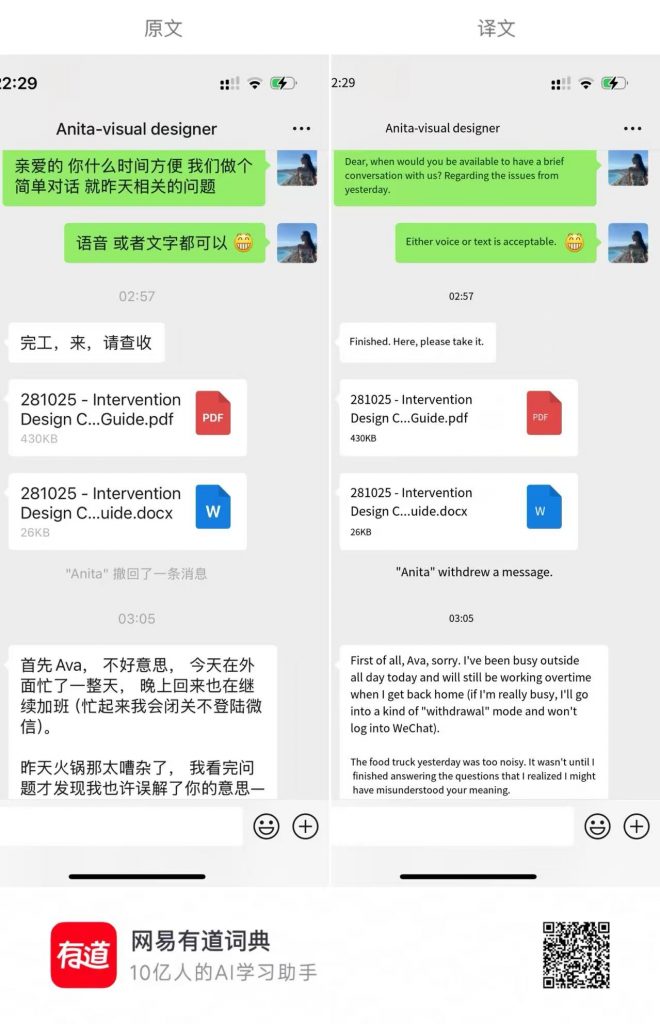Between Code and Care
1. Background
This reflection is based on my interview with Anita, a professional visual designer. The conversation took place in a restaurant. Although the environment was quite noisy, the relaxed setting encouraged a genuine and open exchange. Due to the background noise, the audio recording was not ideal. Fortunately, Anita later took the initiative to organize her responses in written form and sent them to me. Her document has become an important part of my project, Between Code and Care: Observing the Space Between Algorithm and Warmth.
This consultation aimed to understand the designer’s professional perspective on the creative process and to explore the presence of “human warmth” within visual design — that subtle quality often beyond the reach of algorithms.
2. Reflection on the Interview Process
This interview made me realize that authenticity and clarity often cannot coexist.
The informal restaurant setting allowed the designer to speak more freely and emotionally, yet the noise disrupted accurate documentation. However, Anita’s later written version compensated for this limitation. Writing enabled her to reflect more systematically and express her thoughts with greater depth and precision.
This experience helped me recognize that different communication modes stimulate different types of cognition: oral interviews evoke emotional intuition, while written responses tend to reveal analytical reasoning.
3. Key Insights and Learnings from the Designer
(1) On Time and Process Feasibility
Anita stated, “Thirty minutes of software operation cannot represent a complete design process.”
Design is not just execution — it includes research, analysis, inspiration development, and conceptualization. Her point reminded me that while AI improves efficiency, speed can never replace interpretation or reflection. True creativity arises from depth of cognition, not output speed.
Personally, I also felt that thirty minutes was not enough to create an excellent work. Yet, this time constraint encouraged both participants and observers to reflect on the balance between efficiency and creative depth.
(2) On the “Fairness” Between AI and Human Design
Anita pointed out that comparing a designer using AI with one who does not is “not entirely fair,” because their thinking logic, time allocation, and creative rhythm differ fundamentally.
AI focuses on generation and synthesis, while human designers focus on emotional judgment and intuition.
This aligns with my original intention — my experiment does not aim to compare outcomes, but rather to explore differences in creative thinking and emotional engagement.
(3) On the Expression of “Human Warmth”
Anita mentioned that “emotional choices, personal visual language, and spontaneous moments” best convey human warmth.
This made me realize that emotional connection often comes from imperfection and intuition, rather than perfection and precision.
It is this sense of uncertainty and human trace that gives design its vitality.
At the same time, her comments also inspired me to consider new possibilities for my next experiment:
perhaps allowing real-time interaction between audience and designer — where audiences can throw spontaneous ideas or suggestions to the designer and observe how the designer reacts and adapts.
In addition, the audience themselves could attempt parts of the design task, experiencing firsthand the complexity and emotional fluctuation within the creative process.
Such participatory engagement could make “human warmth” more tangible, transforming observation into a form of co-creation.
(4) On Observation Methods
Anita emphasized that designers’ pauses, hesitations, and changes of direction often reveal their thinking and emotions better than software operations.
Her feedback aligned with my observation plan — in addition to screen recording, I will also document behavioural cues and emotional traces to capture the psychological dynamics that represent “human warmth.”
(5) On the Role and Boundary of AI
Anita described AI as currently functioning like “an assistant or a junior designer.”
Its value lies in information integration, expanding perspective, and accelerating experimentation, but the creative core still belongs to humans.
She hopes that in the future, AI could take over repetitive operations and heavy system tasks, enabling designers to focus entirely on creation.
This vision of an “intelligent working environment” reflects a rational expectation of human–AI symbiosis — where AI does not replace human creativity, but frees it.
4. Reflection and Learning
Through this interview, my understanding of “human warmth” has deepened.
It is not merely an emotional tone within a finished design, but the traces of human thinking, hesitation, and decision-making throughout creation.
I realized that this research could further explore how these human cognitive traces can be observed and preserved within digital systems.
I also noticed that professional designers tend to see AI as a collaborator rather than a threat, which broadened my research perspective.
Practically, this experience showed me that multi-modal interviews (oral + written) can generate more comprehensive insights.
Emotionally, it reminded me that genuine research is not simply about data collection — it is about understanding and empathy between people.
5. Personal Reflection
Anita’s final statement left a strong impression on me:
“AI should free designers from mechanical burdens, allowing them to focus their energy back on creation itself.”
Her words made me reinterpret the meaning of “human warmth.”
It is not resistance to AI, but a reclaiming of emotional agency.
Amid the accelerating tide of technology, what truly matters is not speed or perfection,
but the emotional intention and creative impulse that remain uniquely human.
The written consultation document has been attached as supporting material for this reflection and analysis.
Consultation document

Leave a Reply